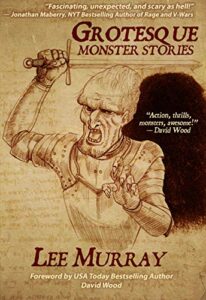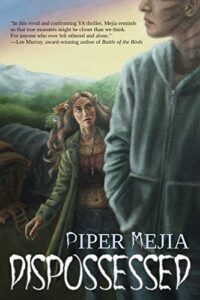 Debbie Cowens is a New Zealand-based writer and teacher. Her short stories can be found in the collection Mansfield with Monsters with Matt Cowens and Katherine Mansfield (Steam Press 2013) , the novella At the Bay of Cthulu with Matt Cowens and Katherine Mansfield, and the anthologies Baby Teeth (2013 Paper Road Press), Steam Pressed Shorts with Matt Cowens (2012 Amazon Digital), and Shades of Sentience (2010 lulu.com).
Debbie Cowens is a New Zealand-based writer and teacher. Her short stories can be found in the collection Mansfield with Monsters with Matt Cowens and Katherine Mansfield (Steam Press 2013) , the novella At the Bay of Cthulu with Matt Cowens and Katherine Mansfield, and the anthologies Baby Teeth (2013 Paper Road Press), Steam Pressed Shorts with Matt Cowens (2012 Amazon Digital), and Shades of Sentience (2010 lulu.com).
1. Can you give our readers a brief introduction?
I’m a writer of a variety of genres – horror, SF, fantasy and crime. I co-authored the book Mansfield with Monsters, published by Steam Press, which is a collection of Katherine Mansfield’s short stories, adapted to include the monstrous and the macabre. I have also written numerous short stories, including the story “Caterpillars” in the recent horror anthology Baby Teeth. I’m currently working a short novel, Mother of the Baskervilles, a darkly comic mashup of Pride and Prejudice and Sherlock Holmes, which casts the Mrs Bennett-style mother as a ruthless serial killer and Elizabeth as an aspiring detective.
2. Why do you write horror? What draws you to the genre?
I’ve always been fascinated with the horror genre. One of the first films I remember making a strong impression on me as a child was the Christopher Lee film version of Dracula, which I watched unbeknownst to my parents as a five year old at my uncle’s house. It didn’t scare me as so much as enthrall. I would often sneak up after bedtime to watch the late night horror movies as a kid and most of the books I would choose to read had a horror or mystery element. As soon as I started writing my own stories, they tended to focus on monsters, which unfortunately worried one of my teachers who didn’t think seven year old girls should be writing about blood and guts or scary things. However, what draws to me the genre is as much the human element as the darker content. I’m fascinated by people and what drives them. Placing characters in truly terrifying situations often reveals more about who they really are and what matters to them than their everyday life. Our fears are an important part of human nature and often the monsters themselves reflect a lot about people and society. The scary ‘other’ in horror is often just a twisted and magnified reflection of ourselves.
3. Can you describe your writing style or the tone you prefer to set for your stories?
I’m a bit of a writing chameleon, adapting my style to suit the characters and scenarios I’m writing. In Mansfield with Monsters I faced the challenge of blending my writing with that of one of the pioneers of Modernism. I’d say the linking element in a lot of my fiction is a sense of humour, often dry and somewhat dark, and a compassion for the characters – even when they are being murdered by possessed children, torn apart by zombies or facing their werewolf packmate and husband drifting away despite the thrill of the chase and the promise of blood. While I love stories of horror and harm, I do tend to like a glimmer of light at the end of the tunnel – a suggestion that the sun might rise again, that there might be, if not salvation, then at least a reprieve before the next onslaught. Like a weekend, or a holiday break away from the being killed.
4. Who are some of your influences? Are there any women authors who have particularly inspired you to write?
I really enjoyed reading Margaret Mahy as a kid and The Haunting was one of my favourites. As a teenager, I devoured a lot of Stephen King and I’m still a fan of his writing. Frankenstein by Mary Shelley was one of the first classic horrors that I read. I loved it; it was moving and compelling, and both beautiful and horrific at the same time. I’m also really fond of the nineteenth century horror classics like Poe and Lovecraft. The Cthulhu mythos sort of redefined my notions of what terrible monsters could be in terms of scale, strangeness and terrifying power. In terms of writing style, I’m more influenced by more modern or at least less florid prose and storytelling.
5. What authors do you like to read? Any recommendations?
I enjoy reading a wide variety of books – anything from historical mysteries, young adult, fantasy, science fiction and of course horror. I like a lot of writers who blur the boundaries between genre and literary like Kate Atkinson, Margaret Atwood and Haruki Murakami. I’ve also recently read a lot of translations of traditional Japanese ghost stories, which are fabulous, and the short stories of Ryunosuke Akutagawa. I just finished two brilliant novels by fellow New Zealand Writers; The Unspeakable Secrets of the Aro Valley by Danyl McLauchlan and The Wind City by Summer Wigmore. Both weird, surreal and darkly humorous tales with more moral complexity than I had anticipated. Next on my to-read list is Wake, a horror novel by New Zealand author Elizabeth Knox.
6. Where can readers find your work?
Mansfield with Monsters is available from Steam Press or on Amazon. At the Bay of Cthulhu, a Lovecraftian take of a Katherine Mansfield novella is available of Amazon. Baby Teeth, the horror anthology is available from Paper Road Press and a selection of my stories are included in Steam Pressed Shorts on Amazon, which includes a range of horror, steampunk, SF and fantasy short stories.
Interested in learning more? Check out Debbie Cowens’ Amazon page, and her blog. For a little more detail on Mansfield with Monsters, take a look at this interview, or this video, which also include her collaborator, Matt Cowens.


 Debbie Cowens is a New Zealand-based writer and teacher. Her short stories can be found in the collection Mansfield with Monsters with Matt Cowens and Katherine Mansfield (Steam Press 2013) , the novella At the Bay of Cthulu with Matt Cowens and Katherine Mansfield, and the anthologies Baby Teeth (2013 Paper Road Press), Steam Pressed Shorts with Matt Cowens (2012 Amazon Digital), and Shades of Sentience (2010 lulu.com).
Debbie Cowens is a New Zealand-based writer and teacher. Her short stories can be found in the collection Mansfield with Monsters with Matt Cowens and Katherine Mansfield (Steam Press 2013) , the novella At the Bay of Cthulu with Matt Cowens and Katherine Mansfield, and the anthologies Baby Teeth (2013 Paper Road Press), Steam Pressed Shorts with Matt Cowens (2012 Amazon Digital), and Shades of Sentience (2010 lulu.com).



Follow Us!